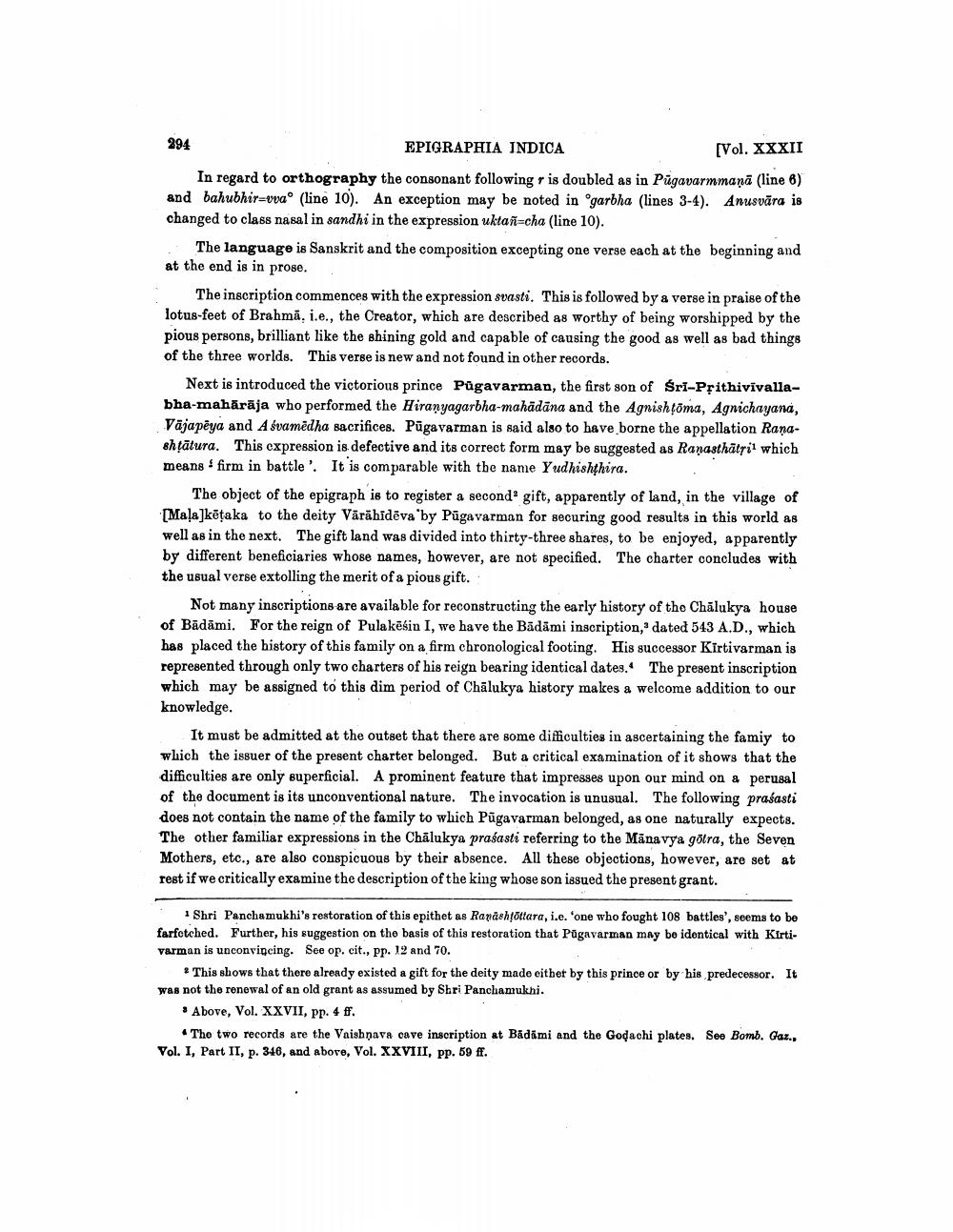________________
294
EPIGRAPHIA INDICA
[Vol. XXXII
In regard to orthography the consonant following r is doubled as in Pugavarmmanā (line 6) and bahubhir-vva (line 10). An exception may be noted in garbha (lines 3-4). Anusvāra is changed to class nasal in sandhi in the expression uktañ-cha (line 10).
The language is Sanskrit and the composition excepting one verse each at the beginning and at the end is in prose.
The inscription commences with the expression svasti. This is followed by a verse in praise of the lotus-feet of Brahma. i.e., the Creator, which are described as worthy of being worshipped by the pious persons, brilliant like the shining gold and capable of causing the good as well as bad things of the three worlds. This verse is new and not found in other records.
Next is introduced the victorious prince Pügavarman, the first son of Sri-Prithivivallabha-mahārāja who performed the Hiranyagarbha-mahādāna and the Agnishtoma, Agnichayana, Vajapeya and Asvamedha sacrifices. Pugavarman is said also to have borne the appellation Ranashtatura. This expression is defective and its correct form may be suggested as Ranasthätri1 which means firm in battle'. It is comparable with the name Yudhishthira.
The object of the epigraph is to register a second gift, apparently of land, in the village of [Mala]kēṭaka to the deity Värähīdēva by Pugavarman for securing good results in this world as well as in the next. The gift land was divided into thirty-three shares, to be enjoyed, apparently by different beneficiaries whose names, however, are not specified. The charter concludes with the usual verse extolling the merit of a pious gift.
Not many inscriptions are available for reconstructing the early history of the Chalukya house of Badami. For the reign of Pulakesin I, we have the Bädämi inscription, dated 543 A.D., which has placed the history of this family on a firm chronological footing. His successor Kirtivarman is represented through only two charters of his reign bearing identical dates. The present inscription which may be assigned to this dim period of Chalukya history makes a welcome addition to our knowledge.
It must be admitted at the outset that there are some difficulties in ascertaining the famiy to which the issuer of the present charter belonged. But a critical examination of it shows that the difficulties are only superficial. A prominent feature that impresses upon our mind on a perusal of the document is its unconventional nature. The invocation is unusual. The following prasasti does not contain the name of the family to which Pugavarman belonged, as one naturally expects. The other familiar expressions in the Chalukya prasasti referring to the Manavya götra, the Seven Mothers, etc., are also conspicuous by their absence. All these objections, however, are set at rest if we critically examine the description of the king whose son issued the present grant.
1 Shri Panchamukhi's restoration of this epithet as Rayashtottara, i.e. 'one who fought 108 battles', seems to be farfetched. Further, his suggestion on the basis of this restoration that Pugavarman may be identical with Kirtivarman is unconvincing. See op. cit., pp. 12 and 70.
2 This shows that there already existed a gift for the deity made either by this prince or by his predecessor. It was not the renewal of an old grant as assumed by Shri Panchamukhi.
Above, Vol. XXVII, pp. 4 ff.
The two records are the Vaishnava cave inscription at Badami and the Godachi plates. See Bomb. Gaz., Vol. I, Part II, p. 346, and above, Vol. XXVIII, pp. 59 ff.




